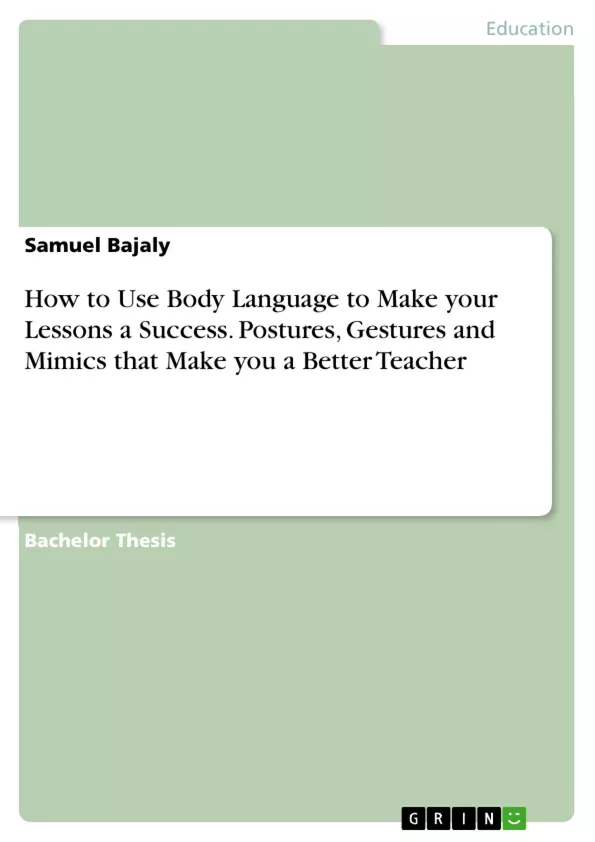The aim of this thesis is to give teachers the right and applicable knowledge about body language to make their lessons a success. But what exactly is a successful lesson?
In this thesis, success and therefore a successful lesson is defined as following: To communicate the subject matter in the most efficient and the most understandable way possible and to ensure that the subject matter is presented in the most understandable way possible is mostly up to the teacher. He needs to know what he is talking about and must be able to communicate it in a way to make it understandable for everyone in the class. Besides the verbal communication, the nonverbal communication is also of importance in this aspect. Effective Teaching is the last body language chapter in this thesis, which is all about postures, mimics and gestures that make the verbal message more understandable and interesting.
By using the information contained in the following chapters, the teacher can analyze, based on the student’s body language, if they engage in the desired behavior. If this is not the case, this thesis provides body language signs for the educator to use, that will cause students to respond with the desired behavior.
This is the reason why this thesis is split up into the four big chapters Motivation, Trust, Respect and Effective Teaching. The didactic purpose of each chapter will be explained in the following segment.
Table of Contents
- What is body language and why is it important?
- As without, so within
- Reading the signs correctly
- How to use body language to make your lessons a success
- The four chapters
- Motivation
- Trust
- Respect
- Effective Teaching
- Structure of this thesis
- Chapter One: Motivation
- Body language that indicates demotivation
- How to use body language to motivate your class
- Body language that indicates motivation
- Summary
- Chapter Two: Trust
- Body language that indicates distrust
- How to use body language to make the class trust you
- Mirroring: The key to someone’s trust
- Body language that indicates trust
- Summary
- Chapter Three: Respect
- Social Hierarchies
- Body language that indicates disrespect
- How to use body language to make the class respect you
- Body language that indicates respect
- Summary
- Chapter Four: Effective Teaching
- Body language that indicates disinterest
- How to use body language to teach your students effectively
- Body language that indicates interest
- Summary
- Closing thoughts
Objectives and Key Themes
This thesis aims to provide teachers with applicable knowledge about body language, focusing on how it can be used to create a successful learning environment. A successful lesson is defined as one where the subject matter is communicated in the most efficient and understandable way possible. The main objectives and key themes of this thesis are:- Analyzing and interpreting student body language to understand their feelings and intentions.
- Applying specific body language techniques to motivate students, build trust, and foster respect.
- Utilizing nonverbal communication to improve teaching effectiveness and enhance student comprehension.
- Exploring the link between body language and emotions, and how the teacher's own posture and gestures can impact the classroom dynamic.
Chapter Summaries
Chapter One: Motivation
This chapter explores the connection between body language and student motivation. It identifies signs of demotivation in students, such as slouched posture, feet pointed towards the door, and zoning out. The chapter then offers practical body language techniques for teachers to motivate their students, including using an upright posture, making eye contact, and using gestures that signal excitement and expectation.Chapter Two: Trust
This chapter examines the importance of trust in the teacher-student relationship and how it can be fostered through nonverbal communication. It identifies body language signals of distrust, such as distancing, crossed arms with clenched fists, and frequent squinting. The chapter then suggests techniques for building trust, including smiling genuinely, tilting one's head, showing open palms, and mirroring the student's body language.Chapter Three: Respect
This chapter delves into the concept of social hierarchies in the classroom and the role of respect in maintaining a stable learning environment. It identifies body language signals of disrespect, such as open legs, a lowered head with lowered eyebrows, and covering the mouth. The chapter then presents strategies for establishing and maintaining respect, including maintaining an upright posture, using strong gestures, and looking at the "third eye" of students who challenge your authority.Chapter Four: Effective Teaching
This chapter focuses on how body language can enhance the effectiveness of teaching. It examines signs of disinterest in students, such as slouched posture, crossed arms and legs, and avoiding eye contact. The chapter then provides tips for engaging students through nonverbal communication, including moving with your lecture, using gestures to highlight important points, and controlling student attention with the use of a pen.Keywords
This thesis explores the importance of nonverbal communication in education, focusing on key concepts such as body language, motivation, trust, respect, and effective teaching. It also examines the influence of the teacher's own posture and gestures on the classroom dynamic, and how to interpret and utilize specific body language signals to create a positive and productive learning environment.- Quote paper
- Samuel Bajaly (Author), 2021, How to Use Body Language to Make your Lessons a Success. Postures, Gestures and Mimics that Make you a Better Teacher, Munich, GRIN Verlag, https://www.grin.com/document/1044778



